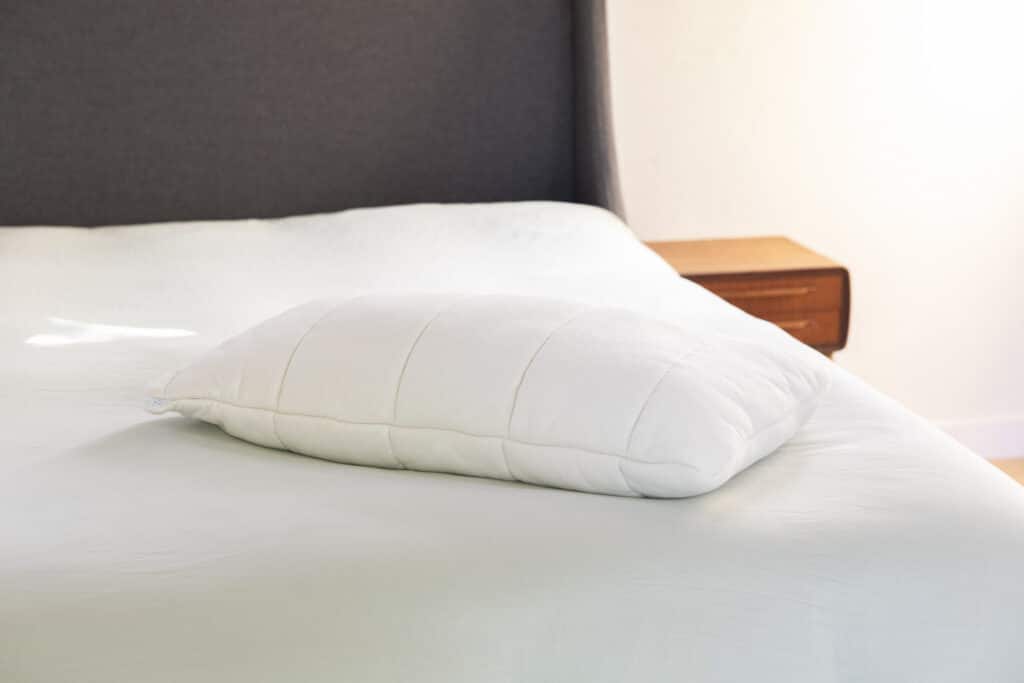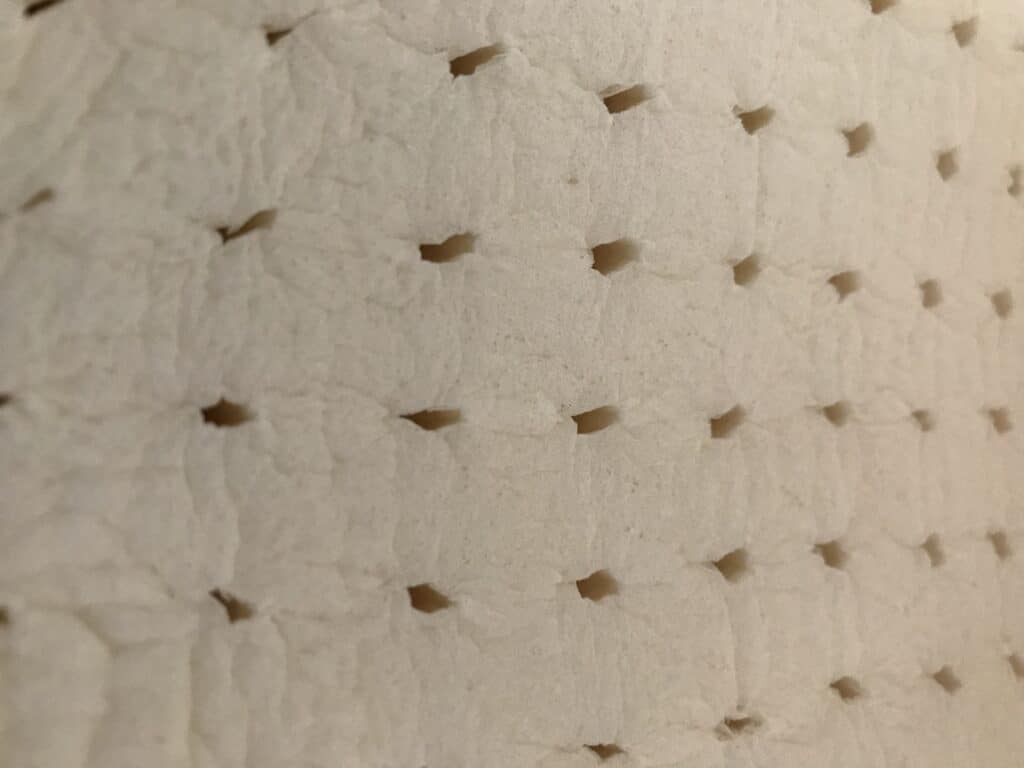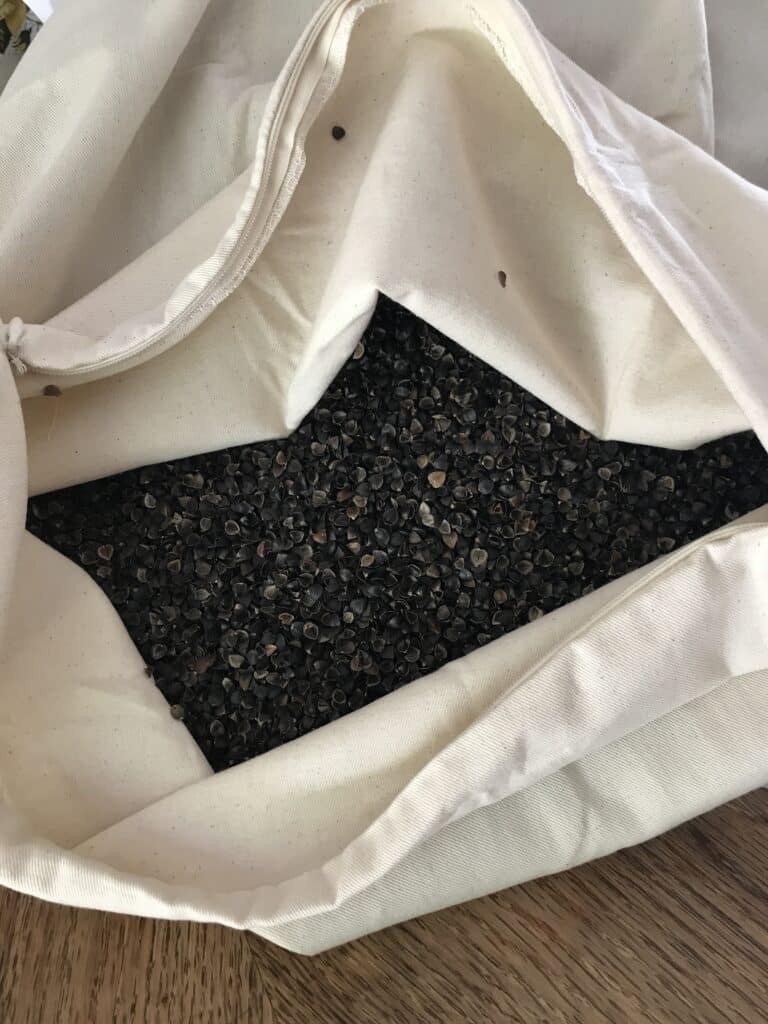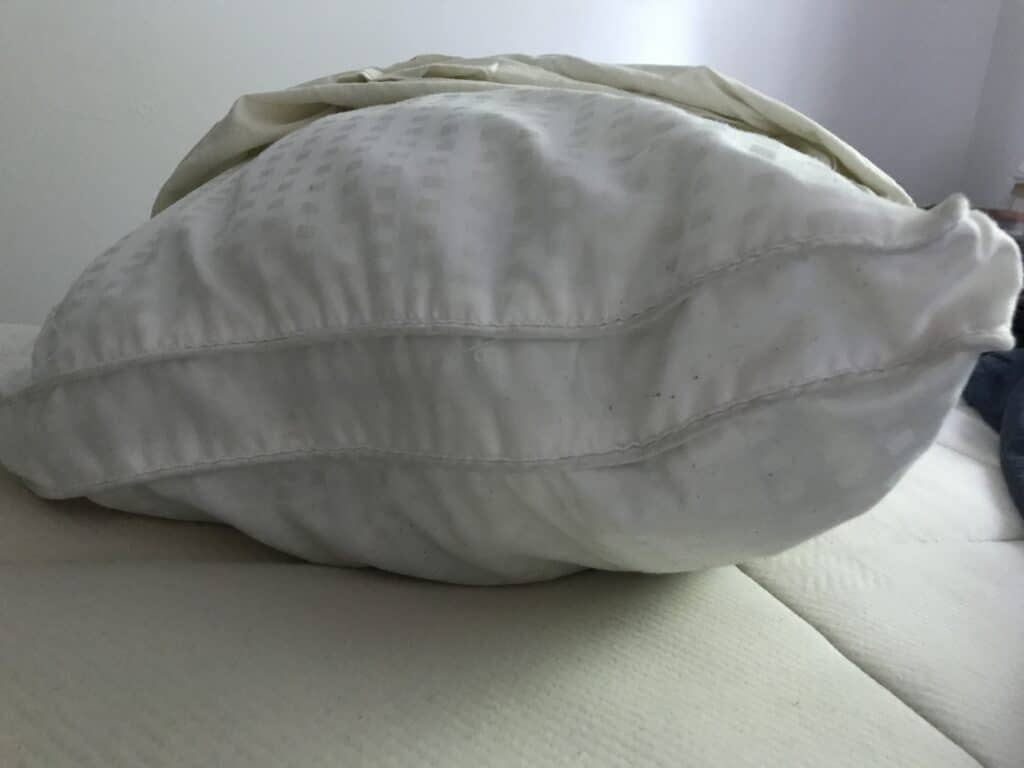There are many factors to consider when choosing a pillow. Some of the most important are the firmness, height, size, and shape of your pillow. As part of our Leaf Score Guide to Non-Toxic Bedding, here’s the lowdown on all of these, and why it’s good to know what a gusset is when pillow-shopping.

Table of Contents
There are many factors to consider when choosing a new pillow.
Once you’ve chosen your pillow materials and know how to avoid hazardous chemicals, it’s onto the finer details such as pillow firmness, size, height, and shape. The best options for you will all depend on how you sleep, your current bed set-up, and the materials you choose.
| Side-sleeper | Back-sleeper | Stomach-sleeper | |
|---|---|---|---|
| Height | 5-7 inches | 3-6 inches | 2-3 inches |
| Firmness | Extra-firm to firm | Medium-firm | Soft |
Pillow firmness
The most important consideration when deciding how firm your pillow should be is how you sleep. Most people (around 70 percent of adults) sleep on their side, so most pillows are designed with this in mind.
If you’re a side-sleeper, you’ll likely want a firmer pillow that maintains its height even as you move around in your sleep. This will help keep your neck and spine in alignment. Good materials for firm pillows include molded latex and hemp.
Stomach-sleepers (like me) will usually want a much softer pillow. Ideally one you can scrunch and compress easily. Good fill materials for this include kapok and shredded latex, as well as buckwheat and millet. And take it from me, you’ll want to choose an adjustable pillow. Like I said above, most pillows are designed with side-sleepers in mind, meaning you’ll probably want to remove about a third to half of the fill of most pillows (this is definitely my experience).
Back-sleepers will usually want a pillow that is medium-firm but allows you to sink in a little. The best kind of pillow is one that gently cradles your head and neck but doesn’t force your head up while you sleep. Adjustable pillows made with shredded latex and kapok are often a top choice for back-sleepers.



Find out more about the best pillows for different sleep positions here.
Firmness ratings can be misleading
As with mattresses, firmness ratings aren’t standardized. What one company calls extra-firm may feel medium-firm to you, and vice versa.
The best approach is to read reviews and choose a pillow with a good return policy. Some companies offer a sleep trial, free exchanges, or low-cost returns if your pillow just isn’t working out for your sleep needs. Other companies don’t accept any returns unless there’s a clear manufacturing issue.
Read the small print before buying!
Also, I’ve found that the choice of pillowcase makes a big difference to pillow firmness. My buckwheat pillow can feel quite firm and unmoving with a smaller pillowcase, but is super adaptable and much softer with an oversize pillowcase that lets the hulls move around. The same is true for most fills other than molded latex.
Pillow height
Pillow height can be a tricky thing to measure, both in terms of what you need and the actual height of a pillow.
To work out the right pillow height for you, consider first how you sleep. The chart below offers a rough guide to the best pillow height based on sleep positions.
| Side-sleeper | Back-sleeper | Stomach-sleeper | |
|---|---|---|---|
| Height | 5-7 inches | 3-6 inches | 2-3 inches |
| Firmness | Extra-firm to firm | Medium-firm | Soft |
If you sleep on your side and have quite wide shoulders, especially narrow shoulders, or a larger or smaller head than average, bear this in mind when choosing a pillow. You may do better with a much taller pillow, for instance, if your shoulders are very wide, or prefer a shallower pillow if you have narrow shoulders.
For stomach-sleepers, a pillow that’s too high will force your head up and cause a crick in your neck. When I’m traveling, I often find that I sleep right on the bottom edge of pillows or without a pillow at all. This is because hotel pillows and those in the guest rooms of family and friends tend to be too firm or too lofty for comfort.
If you’re a back-sleeper who often wakes with lower back and neck pain, you may wonder if this is due to your mattress. While it could be a sign that your mattress isn’t working for you, it can also be an indication that your pillow is too high. Before you shell out thousands for a new mattress, try out a new pillow for a fraction of the price.
What is a pillow gusset?
Pillow measurements usually describe the width and length of a pillow only. However, some pillows have a gusset, which is a strip of fabric around the sides of the pillow, between the top and bottom of the pillow.
The gusset is there to allow more loft or height in the pillow, with less tapered compression at the edges. This is great for side-sleepers who want to maintain pillow height between shoulder and head.

Confusingly, some pillows with gussets don’t expressly detail the size of the gusset. The gusset can, in some cases, be the height of the pillow. In other cases, the height might be the overall height, including the gusset in the middle.
Some pillow makers absorb the gusset into the overall measurements, meaning a queen size pillow might be sold as 18 x 28 x 2 inches. While the pillow seems two inches shorter and narrower than a typical queen size pillow, it would still fit into a 20 x 30 inch queen pillowcase.
If it’s not clear how high the pillow is overall, ask the bedding company.

Try a toddler pillow or travel pillow!
Stomach-sleepers often do best with a smaller pillow with a low profile. So, while it might seem strange, adults who sleep on their front might want to consider buying a toddler pillow or small travel pillow instead of a regular queen or king size pillow.
This is also a great way to save some cash as these are usually less expensive than full-size pillows!
I got my toddler a low-profile latex pillow from Turmerry and couldn’t resist testing it out myself. It’s so much more comfortable than almost any ‘adult’ pillow I’ve ever slept on as a stomach-sleeper!
Pillow shapes
Most pillows have a rectangular shape and an even surface that tapers at the edges. Some pillows, however, have a different design, such as a:
- Molded soap shape, with higher edges and a lower middle
- Ridged surface for better airflow or contoured support
- Wedge, for back support
- L-shape, J-shape, C-shape, or U-shape.
Many side-sleepers, and some back sleepers, do best with a molded latex pillow with a soap shape. This kind of pillow lets you move across the pillow to find your perfect height and adjust as you sleep.
The letter shape pillows are mostly useful during pregnancy or if you have a back injury or ongoing back pain. While very helpful for some people, these kinds of pillows can:
- Make it harder to move around in your sleep
- Be very expensive
- Be hard to find pillowcases for.
I used a longer body pillow while I was pregnant and found it helpful some nights and irritating on other nights. Trying to move a longer body pillow from one side of my body to the other in the night, under a duvet, was a real challenge. This is the beauty of a U-shape pregnancy pillow, although I also tried one of these and immediately felt too confined and insulated for good sleep.
Note, too, that it’s even more challenging to find unusually shaped pillows made with natural materials. This can mean you’re stuck with a hot, sweaty polyester or polyurethane pillow.
One workaround is to make your own pillow. This approach is usually much more sustainable because you’ll likely only need a U-shape or L-shape pillow for a few months in the later stages of pregnancy or while recovering from a back injury. Once you’re done with the pillow, you can easily disassemble it and once again have four, five, or more individual pillows to use as you need.
How to DIY a pregnancy pillow
Using some creative stitching and old pillowcases, create the shape you want for your pillow. This might be a U, C, L, or J, depending on how you sleep. Choose pillowcases with an envelope enclosure, so you can stitch one pillowcase to the next while still containing the pillow inserts in a seamless fashion.
Once you have your design, fill the pillowcases with natural, organic pillows you already own or borrow or buy additional pillows.
The beautiful thing about the DIY approach is that you can use different kinds of pillows in different parts of the U, C, L, or J. You aren’t stuck with just one material and firmness across the pillow as a whole, as you are with store-bought options.
If I were to make my own pregnancy pillow, for example, I would likely have a C-shape with a buckwheat pillow at the top, shredded latex and kapok in the middle and then a firmer shredded latex or even cotton pillow at the bottom. Perfection!
What size should a pillow be?
Pillows come in standard sizes and two pillows typically fit comfortable on either a double/full or queen mattress or a king size or Cali king size mattress.
In general, pillows measure around 20 inches wide across the opening and then vary in length.
| Standard pillow | Standard queen pillow | Queen pillow | King pillow |
|---|---|---|---|
| 20 x 26 inches | 20 x 28 inches | 20 x 30 inches | 20 x 32 inches |
If you have a double bed, king size pillows will be too wide and can overhang the sides of the bed or even fall off during the night. On the flip side, standard or queen size pillows can look strange on a king or Cali king bed and you may fall off the side of the pillow if you’re an active sleeper.
What’s a European pillow?
In Germany, Hungary, and some other European countries, bed pillows are often square rather than rectangular. These are known as European pillows and most often come in the following sizes:
- 26 x 26 inches
- 24 x 24 inches
- 22 x 22 inches
- 20 x 20 inches
- 18 x 18 inches
- 16 x 16 inches.
European pillows are a great addition to any bedroom as they can provide visual interest with contrasting pillow shams, work well as throw pillows, and provide extra support when sitting up in bed.
While it’s usually simplest to just match pillow size to your bed, there are some exceptions. For instance, you may want to choose a standard or standard queen size pillow if:
- You’re on a tighter budget
- You like a more compact pillow
- You don’t tend to move much in your sleep
- You’re a stomach-sleeper.
Conversely, you may want to choose a queen size pillow if:
- You toss and turn a lot in your sleep
- You want a larger pillow for more luxury.
As for king size pillows, these can be a great choice if:
You’re looking for a single longer pillow for a twin or twin XL bed
- You toss and turn a lot at night
- You’re looking for a pillow that also works as a body pillow
- You work, read, or watch TV a lot in bed.
It’s also worth considering your existing bedding when choosing pillows. If you have pillowcases you absolutely love, make sure any new pillow will fit those cases, unless you’re willing and able to buy pillowcases in the same style to fit a larger or smaller pillow.
Final thoughts
Whether a pillow works for you will depend on a wide variety of factors, including its size, shape, height, and firmness. There’s a lot to think about, but it’s well worth it to get the right pillow.
And the nice thing is that with so many choices now available, and so many fantastic eco-friendly, non-toxic pillow options, there’s almost certainly the perfect pillow out there for you.